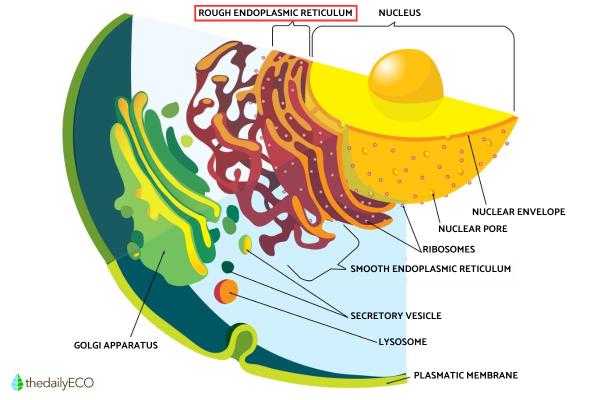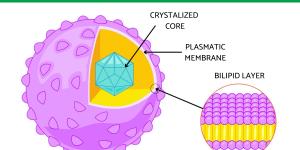What Does the Rough Endoplasmic Reticulum Do?


We continue our series at thedailyECO which describes cellular components by asking what does the rough endoplasmic reticulum do? The rough endoplasmic reticulum (RER) is an essential cellular organelle that plays a critical role in protein synthesis and molecule processing in eukaryotic cells. Its rough appearance is due to the presence of ribosomes attached to its surface. The RER is composed of a complex network of interconnected membranes that extend throughout the cytoplasm. Through its intricate system of sacs and tubules, the RER is responsible for the synthesis and modification of proteins. Specifically, it ensures their correct folding and preparing them for their proper transport in and out of the cell. We provide a definition of this organelle as well as look at the structure and function of the rough endoplasmic reticulum.
What is the rough endoplasmic reticulum?
As a basic definition, we can say the rough endoplasmic reticulum (RER) is characterized by its structure formed by a network of elongated tubules and flattened sacs. These tubules and sacs are stacked in parallel layers, although their form is not always consistent. These structures contain numerous ribosomes attached to their membranes. The number of associated ribosomes determines the shape of the RER, which is why when the number of ribosomes increases, the tubules expand and take the shape of flattened cisternae.
The RER is present in the majority of eukaryotic cells, with exceptions including erythrocytes. It is not present in any prokaryotic cells. The distribution of the rough endoplasmic reticulum varies depending on the type of cell and its activity:
- Glandular cells of the pancreatic acini: the RER adopts a folded sheet shape in the basal part of the cell.
- Hepatocytes: it forms BERG bodies, which have a concentric arrangement.
- Neurons: NISSL granules are formed, which are stained with basic dyes.
- Plasmacytes: RER is distributed throughout the cytoplasm and is located around the nucleus.
- Poorly active cells: the RER is poorly developed and dispersed throughout the cytoplasm.
You can see in the diagram below the ribosomes attached to the stacked layers of the rough endoplasmic reticulum. You can also look at these cellular parts in more detail with our article on what are ribosomes?

Function of the rough endoplasmic reticulum
Now we have a rough endoplasmic reticulum definition, we can discover more about what does the rough endoplasmic reticulum do. The main function of the rough endoplasmic reticulum is to be specialized centers for protein synthesis, thanks to the ribosomes embedded in the organelle. Apart from protein synthesis, the RER has other important functions such as:
- Glycosylation: is the main process of post-translational modification that proteins undergo in the secretory pathway. N-glycosylation is essential for cell survival and plays a fundamental role in the biological activity and physicochemical properties of proteins.
- Synthesis of membrane-bound proteins via glycosylphosphatidylinositol (GPI) anchors: some proteins are attached to the membrane via a GPI anchor. After protein synthesis is completed, the precursor protein remains bound to the RER membrane through a C-terminal hydrophobic sequence of 15-20 residues of the signal peptide. The remainder of the protein is located in the lumen of the RER.
- Response to misfolded proteins: the accumulation of misfolded proteins in the lumen of the RER triggers an adaptive response known as the UPR (unfolded protein response), which coordinates different cellular programs.
- Post-translational modifications: within post-translational modifications, covalent modifications to functional groups (R) and to the amino and carboxyl terminal side chains are included.
Learn about the difference in types of reticula than can be found in cells with our article on what is the smooth endoplasmic reticulum and its function?
Structure of the rough endoplasmic reticulum
The structure of the rough endoplasmic reticulum (RER) is characterized by being formed by a network of interconnected membranes that form flattened sacs and tubules. These sacs and tubules are distributed in the cytoplasm of the cell. These flattened sacs contain ribosomes attached to their surface, giving the RER a rough appearance when viewed under a microscope.
The structure of the RER is described below:
- Membranes: the network of interconnected membranes of the RER forms flattened sacs and tubules. It is composed of a lipid bilayer containing various proteins and associated enzymes.
- Ribosomes: these are attached to the external surface of the RER. These ribosomes are arranged on the cytosolic side of the membrane, at a distance of approximately 15 nm between them. The binding of ribosomes to the rough endoplasmic reticulum occurs through the 60S subunit. This binding is mediated by transmembrane glycoproteins, specifically ribophorin I and II.
- Cisternae and tubules: the RER is organized in the form of cisternae, which are flat, elongated structures, and interconnected tubules. The cisternae have a flattened shape, while the tubules are cylindrical and narrow.
- Lumen of the RER: it is the internal space surrounded by the membranes of the RER. In this lumen, important processes such as the folding and modification of newly synthesized proteins take place before being transported to other parts of the cell.

What is the difference between the rough and the smooth endoplasmic reticulum?
We have already determined that there is both a rough and a smooth endoplasmic reticulum found within most eukaryotic cells. Here are the differences between these types of cell organelles:
- Morphological characteristics: the rough endoplasmic reticulum (RER) exhibits a rough appearance under the electron microscope due to ribosomes attached to its outer surface. In comparison, the smooth endoplasmic reticulum (SER) lacks ribosomes and has a smooth appearance in the electron microscope.
- Primary functions: RER is mainly involved in protein synthesis and modification, while SER plays a wide range of functions. These include lipid synthesis, cellular detoxification, calcium storage and regulation of carbohydrate metabolism.
- Cellular localization: RER is commonly found in cells that synthesize and secrete large amounts of proteins, such as pancreatic cells or antibody-producing cells. The SER is especially abundant in liver and muscle cells, where it performs specific metabolic functions.
- Membrane composition and structure: both the RER and SER are composed of lipid membranes and associated proteins, but the presence of ribosomes in the RER confers a distinctive structure and a different protein composition.
Now that you know what the rough endoplasmic reticulum is, you may be interested in learning about the different types of cells which can be found in nature, as well as the difference between plant and animal cells.

If you want to read similar articles to What Does the Rough Endoplasmic Reticulum Do?, we recommend you visit our Biology category.
- Alberts, B., Johnson, A., Lewis, J., Raff, M., Roberts, K., & Walter, P. (2002). Molecular Biology of the Cell (4th ed.). Garland Science.
- Resino, S. (2013). Endoplasmic reticulum. Molecular Epidemiology of Infectious Diseases. https://epidemiologiamolecular.com/retculo-endoplasmico/








